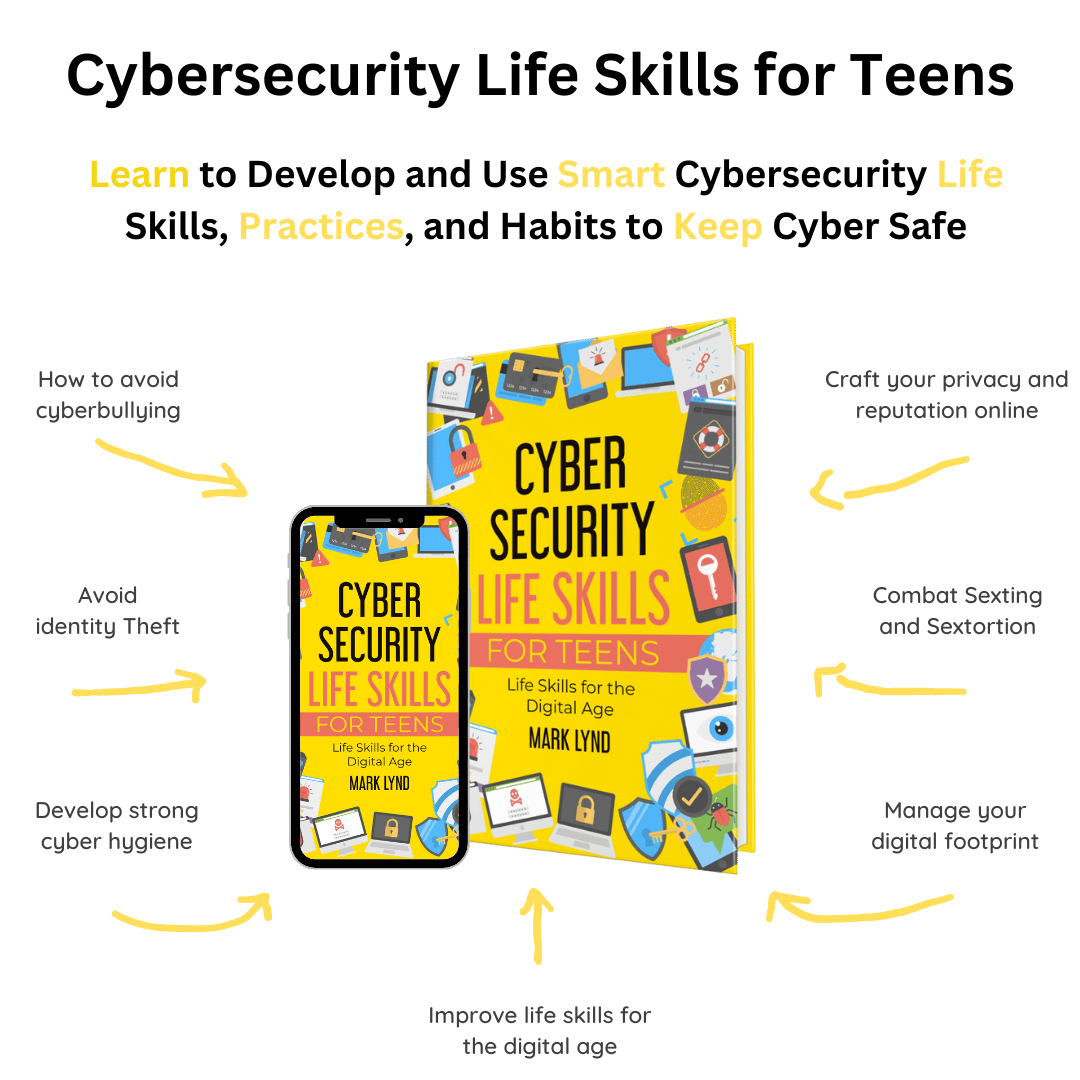
You have a lot going on, so join the thousands of other leaders and let me do the work and provide you with curated cybersecurity content. It would be my honor to do so.

NOTES: If you want to ensure you get this newsletter every week, please add my "from" address to your contact list. If you would like to Unsubscribe scroll to the bottom and select "unsubscribe". Thank you.
In this week's edition:
New Book Launched Today By Author
Cyber Stats
Early Warning - 7 Most Common Types of Ransomware
Featured Article - 7 Urgent Reasons Why Teens Need to Cultivate Cybersecurity Skills
Free Cybersecurity Resources - eBooks, tools, apps & services
Trending Story - 7 tips for tackling cyber security technical debt
Cybersecurity News Highlights
Cyber Scam of the Week - AI Phishbait
Social Posts of the Week

Cyber Bits & Bytes
New Book Release Today by the Author of this Newsletter
In today’s digital age, it’s more important than ever for teens to be equipped with the knowledge and skills to navigate the online world safely and securely. “Cybersecurity Life Skills for Teens” is an essential guide to help teens protect their privacy, reputation, security, and themselves while online. This book covers everything from the basics of cybersecurity and social media savvy to careers in cybersecurity.
It is my hope that this book will inspire, educate and provide hope to those that are most vulnerable... our teens. - Mark Lynd

Cyber Stats
Here are some interesting cybersecurity statistics:
Cyberattacks are more likely to bring down F-35 jets than missiles
Over 75% of targeted cyberattacks start with an email
Global cybercrime costs are expected to grow by 15% per year over the next five years, reaching $10.5 trillion annually by 2025
According to a study, there are 4.2 million active cybersecurity professionals across the globe
The global cyber insurance market will expand at a CAGR of 25.3% between 2021 and 2028. It’s expected to reach $36.85 billion in 2028
300,000 new malware is created every day
92% of malware was delivered via email
4.1 million websites have malware at any given time 1.
Sources: cybertalk.org, getastra.com, forbes.com,financesonline.com, csoonline.com, and fortninet.com.
Early Warning - 7 Most Common Types of Ransomware
Ransomware attacks are causing devastation all over the globe and the threat is growing.
Here are the 7 most common types of ransomware:
Sources: 1. enterprisenetworkingplanet.com 2. crowdstrike.com 3. otava.com 4. techtarget.com 5. cisa.gov
Featured Original Article
7 Urgent Reasons Why Teens Need to Cultivate Cybersecurity Skills

The online world has lots of risks for teens
Smartphones and the Internet have become an integral part of our lives, offering innumerable opportunities for learning, socializing, and entertainment. Yet, they also harbor many risks, especially for teenagers who may not fully grasp the potential dangers. The importance of cybersecurity for teens cannot be overstated, as it equips them with the knowledge and tools to navigate the online world and be cyber-safe.
This article delves into seven reasons teens must cultivate cybersecurity skills, emphasizing the cyber risks they face daily:
1. Teens are prime targets for cybercriminals
Teenagers are often seen as easy prey for cybercriminals due to their relative inexperience and trusting nature. A study by McAfee revealed that 87% of teens had been approached by strangers online. Cybercriminals often target popular sites and apps frequented by young users, armed with the knowledge that they may be less cautious and more willing to engage with people they do not know. They use social engineering tactics, such as posing as friends or trusted authority, to lure unsuspecting teens into divulging sensitive information or taking risky actions. This vulnerability makes them susceptible to various threats, such as identity theft, phishing attacks, and malware.
Identity theft is a growing problem for teens. Cybercriminals may use teens' personal information, such as Social Security numbers or dates of birth, to open credit accounts, take out loans, or commit other forms of fraud. Unlike adults, who often monitor their credit reports, teens may not become aware of identity theft until they apply for a loan or credit card later in life. Educating teenagers about the risks of sharing personal information and the importance of monitoring their credit can help mitigate identity theft risk.
Phishing attacks are another common danger for teens. These attacks often come in the form of deceptive emails, text messages, posts, or social media direct messages that appear to be from legitimate sources. They entice the teen to click on a link or download an attachment, which can compromise their device or steal their personal information. Teens must learn to recognize suspicious messages and verify the sender's authenticity before engaging with the content to combat phishing.
Malware, including viruses, ransomware, and spyware, can also pose a significant threat to teenagers. Cybercriminals often use malware to gain unauthorized access to a user's device, steal sensitive information, or cause damage to the system. Teens can unknowingly download malware by visiting malicious websites, clicking on pop-up ads, or opening infected email attachments. To protect themselves, they should be taught about the dangers of malware, the importance of keeping their devices updated with the latest security patches, and the value of using reputable antivirus software.
Sadly, teens are prime targets for cybercriminals, and this highlights the importance of cybersecurity education. By teaching them about the risks they face and providing guidance on safeguarding their personal information and devices, parents and educators can help teens build a strong foundation in cybersecurity and empower them to navigate the online world with confidence and security.
2. Teens are often careless with their personal information
Teenagers' tendency to be less cautious with their personal data can leave them vulnerable to cyber threats. They often share sensitive information like their full names, addresses, phone numbers, and school names on social media platforms, chat rooms, and online forums. This carelessness can have serious consequences, such as identity theft, cyberstalking, and targeted phishing attacks. By understanding the potential dangers of oversharing and adopting safe online habits, teens can better protect their personal information.
A 2020 Norton LifeLock report found that 65% of teens shared their real names online, while 25% shared their email addresses. Cybercriminals can exploit this seemingly innocuous information to piece together a teen's digital identity, enabling them to impersonate the individual or gain access to their online accounts. In addition to being more vigilant about what they share, teens should be encouraged to use privacy settings on social media platforms to limit who can view their personal information.
Another risk associated with sharing personal information is the potential for cyberstalking. Online predators and cyberstalkers can use information from a teen's social media profiles, posts, and comments to track their movements, establish their daily routines, and determine their physical location. Cyberstalking can be profoundly unsettling and potentially dangerous, so teens must understand the importance of limiting the information they share online and being mindful of the potential consequences.
Oversharing can also expose teens to targeted phishing attacks. Armed with personal information such as a teen's school or extracurricular activities, cybercriminals can craft persuasive phishing messages that appear to be from trusted sources, like a teacher or coach. These messages may prompt the teen to reveal additional sensitive information or download malicious software, compromising their privacy and security. To combat targeted phishing, teens should be taught to think critically about the messages they receive and verify the sender's authenticity before engaging with the content.
Parents and educators must stress the importance of safeguarding personal information to protect teens from cyber threats and help them develop a strong sense of digital citizenship. By understanding the value of their personal information and the potential dangers associated with sharing it, teens can make more informed decisions about their online activities and interactions.
Teens are often careless with their personal information highlights the need for comprehensive cybersecurity education. Parents and educators can help teens develop a strong foundation in cybersecurity and navigate the digital world with confidence and safety by teaching them about the risks associated with oversharing and providing guidance on protecting their personal data.

3. Teens are at risk of cyberbullying and sextortion
Cyberbullying and sextortion are two significant threats that teenagers face in the online world. These malicious activities can have severe psychological and emotional consequences and long-lasting impacts on the victims' lives. As of 2020, the cyberbullying victimization rate among middle and high school students stands at an all-time high. By understanding the prevalence and dangers of these cyber threats and adopting safe online habits, teens can better protect themselves.
Cyberbullying is a pervasive issue that affects many teens, with the potential to cause significant distress, anxiety, depression, and even suicidal thoughts. According to a 2021 report by the Cyberbullying Research Center, 36.5% of teens have experienced cyberbullying, either as a victim, perpetrator, or witness. Bullying can take various forms, including hurtful comments, spreading rumors, sharing embarrassing photos, or creating fake profiles to harass the target. To address cyberbullying, teens must learn to recognize and report incidents and develop resilience and empathy to support their peers.
Sextortion is the act of coercing someone into sending explicit images or performing sexual acts. It is a growing threat, particularly among teenagers. Perpetrators often use manipulative tactics, such as blackmail or threats of exposure, to exploit their victims. According to a 2020 Thorn report, 1 in 10 young adults have experienced sextortion, and 45% of victims were under 17 years old at the time of the incident. To protect themselves from sextortion, teens should be educated about the risks of sharing explicit content, the importance of reporting incidents to a trusted adult, and the legal consequences for both the perpetrator and the victim if explicit images of minors are involved.
Developing strong cybersecurity skills can help teens recognize and prevent cyberbullying and sextortion. For instance, they should be encouraged to use privacy settings on social media platforms to limit who can view their profiles, posts, and personal information. Additionally, they should be taught to think critically about the people they interact with online, the content they share, and how to block or report users who engage in inappropriate or threatening behavior.
Parents, educators, and mentors can play a crucial role in addressing these threats by fostering open and supportive communication. Encourage teens to discuss their online experiences, both positive and negative, and provide guidance on how to handle challenging situations. Establishing a safe and trusting environment for these conversations can empower teens to seek help when they encounter cyberbullying or sextortion, ensuring their online experiences remain positive and safe.
The risks of cyberbullying and sextortion highlight the importance of cybersecurity education for teenagers. Parents and educators can help teens build a strong foundation in cybersecurity and navigate the online world with confidence and security by teaching them about the dangers they face and providing the tools to protect themselves.
Free Resources
CSO Online: "The CSO guide to top security conferences"
Web Security Academy - Free, online web security training
At Bay - Free Cyber risk Calculator
Trending Story
Other Bytes

Cyber Scam of the Week
AI Phishbait
Artificial intelligence (AI) has become increasingly popular in the past year. Many people have started using AI chatbots like ChatGPT or Google Bard. Unfortunately, cybercriminals are taking advantage of AI’s popularity to steal your information.
In a recent scam, cybercriminals created fake Facebook ads for free downloads of AI products. If you click one of these ads, you’ll be prompted to download a fake file. Once you download the file, malware will be activated on your device. Cybercriminals can use this malware to steal sensitive information, such as your credit card numbers and passwords.
Follow the tips below to stay safe from similar scams:
Cybercriminals can buy ads anywhere. So, always think before you click.
Only download files from trusted sources, such as the official Google or AI website. Watch out for ads that prompt you to click links instead of visiting official websites.
Before you click an ad, hover your mouse over it to view the related link. Make sure that the link leads to a legitimate, safe website that corresponds with the content in the ad.


